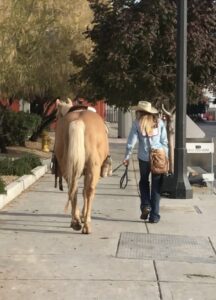Roping With Jordyn
![Schaefer In Action [Photo: submitted]](https://dakotahorsemagazine.com/wp-content/uploads/2022/12/Schaefer-In-Action.jpg)
Some tips about breakaway roping that I have found to help me be successful and that I’d like to share are:
1. Always have a family member or even a couple of friends around to practice with. Push each other to the best that you can do and learn from each other, share insights and knowledge with everyone.
Having a competitive match during practice helps keep your mind sharp and helps get the feel for the next competitive run. Keep your practice circle small, so you can take time to break things down and work on them and don’t feel rushed.
2. Make practice and competition fun. You can learn something from every run, whether it’s good or bad.
3. Practice whenever you can. It doesn’t matter if it’s on live cattle or on the dummy, work on muscle memory. Moving positions on the ground while roping the dummy helps immolate live cattle. Move to the left or right, so you can get a feel for your tip position when your calf moves left or right.
4. Always ask for advice, it doesn’t matter who you ask. Don’t feel bad for asking. Everyone started in the same place, and you have to start somewhere. Ask advice on the start/barrier, your calf, swing/delivery, pulling slack and horses stop.
5. Take notes on the calves whenever you have the chance. It will help with your start, and you will have an idea how hard/slow your calf will run, if it goes left/right, stops, etc.
6. Think about limiting your practice runs. Just because you want to rope a lot of calves, doesn’t mean your horse needs all the runs. A general rule I follow is to make 2 runs for yourself, 2 runs for your horse and then 2 competitive runs for you and your horse. Make sure you get a good start, good delivery, good stop. I always like to start and end with a score, with several in between.
7. Make realistic goals for the year. Work on them as often as you can, consistency is a key factor in reaching goals.
8. Don’t let the weather stop you from practicing, because you never know what the weather conditions will be at a rodeo or jackpot. If you don’t put in the work, someone else is and they will more than likely beat you come rain, snow, heat or shine.
9. Ask the judges/producer/director what the barrier is set at. Make sure you know what calf number you have drawn. Make time to look at your calf before the rodeo starts and always double check that the correct calf is in the chute when it’s your turn to rope.
10. Try to video as many runs as you can. You can figure out what you need to fix in your next run. It will also help you see the start better for the next time you are at a rodeo with the same set up/barrier.
11. I try to make sure that I always hold my slack at my back pocket- during a rodeo run and in the practice pen. Holding it will help prevent me from pitching my slack and the calf running through, catching a leg or even the figure 8 coming back around and your loop coming off.
12. Always have extra ropes in your rope cans. The temperatures and weather conditions can really change a rope and it won’t feel the same. I always keep a couple extra ropes in my rope can that still feel good just for muddy rodeos. Rope the dummy a couple times before the rodeo to get a good feel for your rope that you choose to use.
13. Learning to rope on different horses helps advance your skill a lot. It works on your horsemanship and being able to rope on different strides. One horse may have a longer neck than another, so your swing will feel different.
Roping is a life-long sport and ever evolving. Ropers, including myself, are supporting the journey of roping and look forward to seeing you in the arena. Until next time, ‘happy ropin’-Jordyn.

Jordyn & her horse, Robert, In Las Vegas Competing At Rope For The Crown In 2019 [Photo: submitted]

Jordyn Schaefer was born and raised in the small town of Des Lacs, ND. She grew up riding horses and roping with her dad, Jeff Schaefer. At the age of 7, she started rodeoing and competed in barrel racing. It wasn’t long until she realized that barrels weren’t for her and made the switch to roping. Jordyn now competes in breakaway roping, team roping (both heading and heeling). She is very thankful to her dad for teaching her what she knows today. When she is not on the rodeo trail, she cherishes her job as a Vet Assistant for Schaefer Veterinary Service.
Some of Jordyn’s accomplishments include: Multiple time NDRA qualifier in the breakaway roping, multiple time NDRA Reserve Women’s All-Around and Reserve Ladies Breakaway Roping Champion & NDRA average winner. She was the 2019 NDRA Women’s All-Around Champion and was a Badlands Circuit Finals qualifier in Breakaway Roping.
